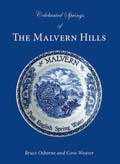
| 
|


Chalybeate Spring or Dog Well
NGR 77817 45727
Site Number: C97
By Bruce Osborne and Cora Weaver (C) 2012
Area 1. Malvern Town Centre Springs and Wells
Malvern Hills, England
The Malvern Chalybeate Spring is of great antiquity and is as renowned as the Holy Well and St Ann's Well. It was originally on land owned by Malvern Priory, which was dissolved in 1539. Six years later most of the monastic buildings and lands were bought by a local wealthy landowner, John Knotsford. He bequeathed his estate to his daughter Anne Savage and it stayed in that family until 1774 when Alderman James Oliver of Worcester bought many acres of local land from the Savage family. Oliver bequeathed it to his daughter Elizabeth Mason and she in turn left it to her six children.

The spring does not appear on any seventeenth-century maps of Malvern, but first appears on the Foley Estate map of 1744 where it is named Dog Well. This may have been because mangy dogs were notorious for lounging around in chalybeate water to relieve their itchiness.
Dr Short, one of the great practitioners of mineral waters, described the Dog Well in 1740 as weak chalybeate water.[2] Smith, in his History of Malvern, confirms that this source was also known as the Dog Well. It appeared on the Foley Estate map of 1744 where it is named Dog Well and owned by the Byrche Savage family. An earlier possible reference is dated 1540 when it was described as "Le Lyme Pyts."
The Cure at the Spring - Curing at the spring appears to have had a fluctuating history. In Philosophical Transactions (20 and 57) it is recorded that an ancient bishop endowed a hospital in Ledburgh for the reception and entertainment of distressed persons going from Hereford to these healing waters.
In his A Treatise on Mineral Waters of 1770 Dr Munro confirmed the location as about a quarter of a mile below the town. Quoting Dr Wall, he confirmed that when oak galls were introduced at the spring head the water instantly turned purple.[5] Adding crushed galls was a well know test for confirming the iron content of water.
By 1803 the spring was noted as eminently serviceable in the treatment of consumptive complaints (tuberculosis), nervous disorders and emaciated constitutions.[6]Five years later it was mentioned as being in the meadow below the town and to be quite neglected.[7] A Guide to all the Watering and Sea-Bathing Places for 1813 describes it as being "once highly celebrated, but now in a great measure neglected" (p.299).
John Chambers' description of the well in 1817 is charming. The spring, he said, was about a quarter of a mile from the church at the end of a delightful little lane. The spring was sunk into the ground just in front of a thick hazel hedge, and was almost hidden by grass and moss. The sides were bricked up, but the water flowed over one of the sides and into a brickwork basin. All round the mouth of the basin was the deep orange encrustation that was typical of chalybeate springs. Tree leaves had been put at the mouth of the basin to act as pipes and the water escaped from the basin through the 'pipes'. Nearby was a covered seat where visitors could shelter from the sun or rain, and it had been suggested that a small room might be built where the drinking glasses could be kept.[8] Not long afterwards the spring was considered 'once highly celebrated, but now in a great measure neglected'.
By 1820 the spring was enclosed with a locked white iron railing though access could be secured by borrowing the key from the Library. At that time it was also described as being "up a cave enclosed by a white railing".[9] What had happened to the spring? 'In consequence of injudicious interference at the beginning of the present century, the spring was lost, and endeavours to rediscover it proved fruitless till about 1825, when it was found a short distance from the original site', recorded local chemist Mr Alfred Mander.[13] Being on private property it was regretted that greater use could not be made of the chalybeate waters. In the 1820s the landowner, Mr Mason, was digging out the area because the water, and its orange deposits, lay all over the place and it was difficult to see which bit of the water was the most highly impregnated with iron. He wanted to put the spring in order, build a well-house over it, make three new paths to the spring, provide landscaped gardens, and build one or two fine houses near the well-house.[10] However, it is a mistake to build over a spring. Digging near a spring will often divert it; it is better to build a separate well-house and pipe water from the spring to the well-house. Iron waters become unstable when they come into contact with air, so they are not suited to bottling or storage, and should always be drunk at the source. That's why it was so important to have a well-house. Mr Mason was also improving Swan Pool so that the Company who came to Malvern every summer could sit round its shaded edges.
The well house was synonymous with Spa Cottage built c.1840 as Norman May notes that the spring rose at Spa Cottage near the Swan Pool.[11] The Malvern tithe apportionment of 1846 [12] shows that the new cottage was occupied by local surgeon William Addison, who was probably supervising the use of the water by invalids. Mr Alfred Mander in 1895 provided notes which were published in the Malvern Guardian of that year: "In consequence of injudicious interference at the beginning of the present century, the spring was lost, and endeavours to rediscover it proved fruitless till about 1825, when it was found a short distance from the original site".[13]
Analyses of the Water - The description chalybeate (pronounced ka-lib-i-ate) is generally reserved for an iron bearing spring and as such makes this spring distinctive among Malvern sources. There is a suggestion that it was named in error but deposits at the Spa Cottage suggest some iron content. The spring came to the attention of Dr Wall in the eighteenth century and he noted that evaporation of two quarts yielded one grain of earth, one grain of iron and nearly the same quantity of muriatic salt. [15] Chambers also notes that based on Dr Wall's observations the spring is only mildly chalybeate and several cases are cited as examples of the source's efficacy. Southall notes that the waters at Scarborough and Cheltenham contain the same amount of iron as at Malvern but those at Tunbridge contain three times more iron. Lamb, c.1845, goes even further in comparing the Malvern chalybeate with springs elsewhere. The Pouhon and Tonbridge Wells waters contain four to six times more earthy matter. The iron in the Malvern source, observes Lamb, exists in a state of proto-carbonate and that a chalybeate spring is perhaps the most valuable of all springs. Lamb's view appears to be based on the earlier work of Addison. A warning accompanies the text however. Chalybeate waters are incompatible with certain conditions of the body. Those who expect beneficial effects should apply the waters with care and caution because serious evils may accrue from an injurious perseverance.[16]
The early 19th century saw the spring again fading into obscurity and so the Malvern Improvement Association reopened the spring in 1924. At a cost of 10 pounds for investigating the spring, the town surveyor believed that its source lay at Pembroke, the adjacent house, on the north side, in Priory Road.[14] An analysis was conducted by Mr Duncan, County Analyst for Worcestershire and that when sampled, the spring was disturbed and gave varying figures for the mineral analysis.[17] It was found that the spring was only weakly chalybeate, but nevertheless had a slight medicinal effect if it was drunk on the spot. It was described as hill water which had come into contact with hill debris and the Upper Keuper Marls.
No doubt as a result of reassurance from the analysis conducted when the spring was reopened in 1924[18] there was a proposal in November 1928 by Captain Fergusson, a member of Malvern Urban District Council, who suggested changing the town's name to Malvern Spa. Few agreed with him. They argued that a 'spa' had to have mineralised water. After all this, the town didn't change its name and the spring continued on its cycle of being one minute feted, the next minute forgotten.
As a Water Cure - Iron waters are characteristically unstable once they come into contact with air so are not suited to bottling or storage. The water has to be drunk at source, "but that when so drunk, sat lightly on the stomach and was not apt to heat the blood" [19] so it was eminently suitable for the water cure patients who flocked here during Malvern's heyday as a spa town from the 1840s - 1870s. The water was reputedly good for worms, colic, the melancholy and enriching the blood; it was suited to the treatment of the vapours, killed flatworms in the belly, loosened the clammy humours of the body and dried the brain; it could also make the fat lean and the lean fat.[20] It was not recommended for the waters to be taken by the aged, consumptives, the badly fevered or rheumatics.[21]
Spa Cottage remained in the Mason family until shortly after 1846 when it was purchased by Dr Wilson who locked it to exclude his rival Dr Gully's patients. [22] John Leech's Three Weeks in Wet Sheets (1851) notes that the Chalybeate spring was owned by Dr Wilson who controlled access. Dr Gully retaliated by buying an adjacent strip of land to give his patients access to the garden of the cottage.[23] The Malvern Advertiser of 19 Oct 1878 reports that a child fell into Swan Pool and the article mentioned "...the public pathway leading along the east edge of Swan Pool and passing in front of Dr Gully's baths...", confirming that Dr Gully had a small establishment for treatment with the chalybeate water.

Spa Cottage still exists in Priory Road. It is now a private residence but retains evidence of being the lower source of the spring: there are emissions from various pipes and chambers under the rear garden of the cottage and much of the pipework is of considerable antiquity. A flowing spout by the cellar steps suggests that the cellars may have been the point where the water was collected for use. The extension with the high front gable is more recent and the castellations are gone from the original cottage.
Illustrations:
1. The original Chalybeate Cottage.
2. The cottage today less castellations and with a gabled wing.
3. The source water in the rear garden.
4. Invalids once took the cure using water from the cellar at Chalybeate Cottage.
Footnotes: (not in numerical order in main text)
[1] A Guide to all the Watering and Sea-Bathing Places for 1813 p.504-5.
[2] Short T. History of the Principal Mineral Waters, 2nd ed. (1740) BL 34d16, p.88.
[3] Smith B. A History of Malvern, 1964 p.171-178.
[4] Chambers J. A General History of Malvern, 1817, p.278.
[5] Munro D 1770 A Treatise on Mineral Waters. Wilson, Durham.p.270.
[6] Barrett J. A Description of Malvern, 1803 p.36/7.
[7] Capper B. Topographical Dictionary, 1808.
[8] Chambers 1817 p.110/1.
[9] Richardson L. Wells and Springs of Worcestershire, 1930 p.118.
[10] Southall M. A Description of Malvern, 1825 p.11/12. CFW HAS QUERY ON THIS REF.
[11] May N. A Guide to Malvern, 1882 p.142.
[12] WRO 10603/1 (xii)2 microfilm.
[13] Malvern Guardian, January 1895 p.16.
[14] MUDC minutes, 4 November 1924.
[15] Munro D. A Treatise on Mineral Waters, 1770 p.270.
[16] Lamb H. A Guide to Malvern, c.1845.
[17] Richardson 1930 p.118.
[18] Minutes Malvern Urban District Council 4 November 1924.
[19] Southall M. 1825 p.11/12.
[20] Addison W. English Spas, 1951 p.22.
[21] Turner E. Taking the Cure, 1967 p.38-49.
[22] Smith 1964 p.198,201,213.
[23] Harcup J. The Malvern Water Cure, 1992 p.41.
NOTE:The two Southall references conform to Aquae Malvernensis but do not conform to BEO's copy of Southall.

Website: Click Here
SUPPLEMENTARY INFORMATION

Celebrated Springs of
THE MALVERN HILLS
 A definitive work that is the culmination of 20 years researching the springs and wells of the Malvern Hills, published by Phillimore. This is the ideal explorers guide enabling the reader to discover the location and often the astounding and long forgotten history of over 130 celebrated springs and wells sites around the Malvern Hills. The book is hard back with dust cover, large quarto size with lavish illustrations and extended text. Celebrated Springs contains about 200 illustrations and well researched text over a similar number of pages, together with seven area maps to guide the explorer to the locations around the Malvern Hills. It also includes details on the long history of bottling water in the Malvern Hills.
A definitive work that is the culmination of 20 years researching the springs and wells of the Malvern Hills, published by Phillimore. This is the ideal explorers guide enabling the reader to discover the location and often the astounding and long forgotten history of over 130 celebrated springs and wells sites around the Malvern Hills. The book is hard back with dust cover, large quarto size with lavish illustrations and extended text. Celebrated Springs contains about 200 illustrations and well researched text over a similar number of pages, together with seven area maps to guide the explorer to the locations around the Malvern Hills. It also includes details on the long history of bottling water in the Malvern Hills.
Written by Bruce Osborne and Cora Weaver, this book is available on-line for £15.00 (delivered UK) - click Malvern Bookshop on the green panel top left. Alternatively send a cheque payable to Cora Weaver with your name and address to 4 Hall Green, Malvern, Worcs. WR14 3QX.
1) TOPOGRAPHICAL LOCATION:
Malvern Hills - arguably Britain's original National Park
2) LANDSCAPE:
Built Up Location3) INFORMATION CATEGORY:
A Spring, Spout, Fountain or Holy Well Site4) MALVERN SPRING OR WELL SITE DETAILS:
3 SPLASHES - Of Moderate Interest
5) GENERAL VISITOR INFORMATION:
Access On FootOn Private Property
Not Open To Public


